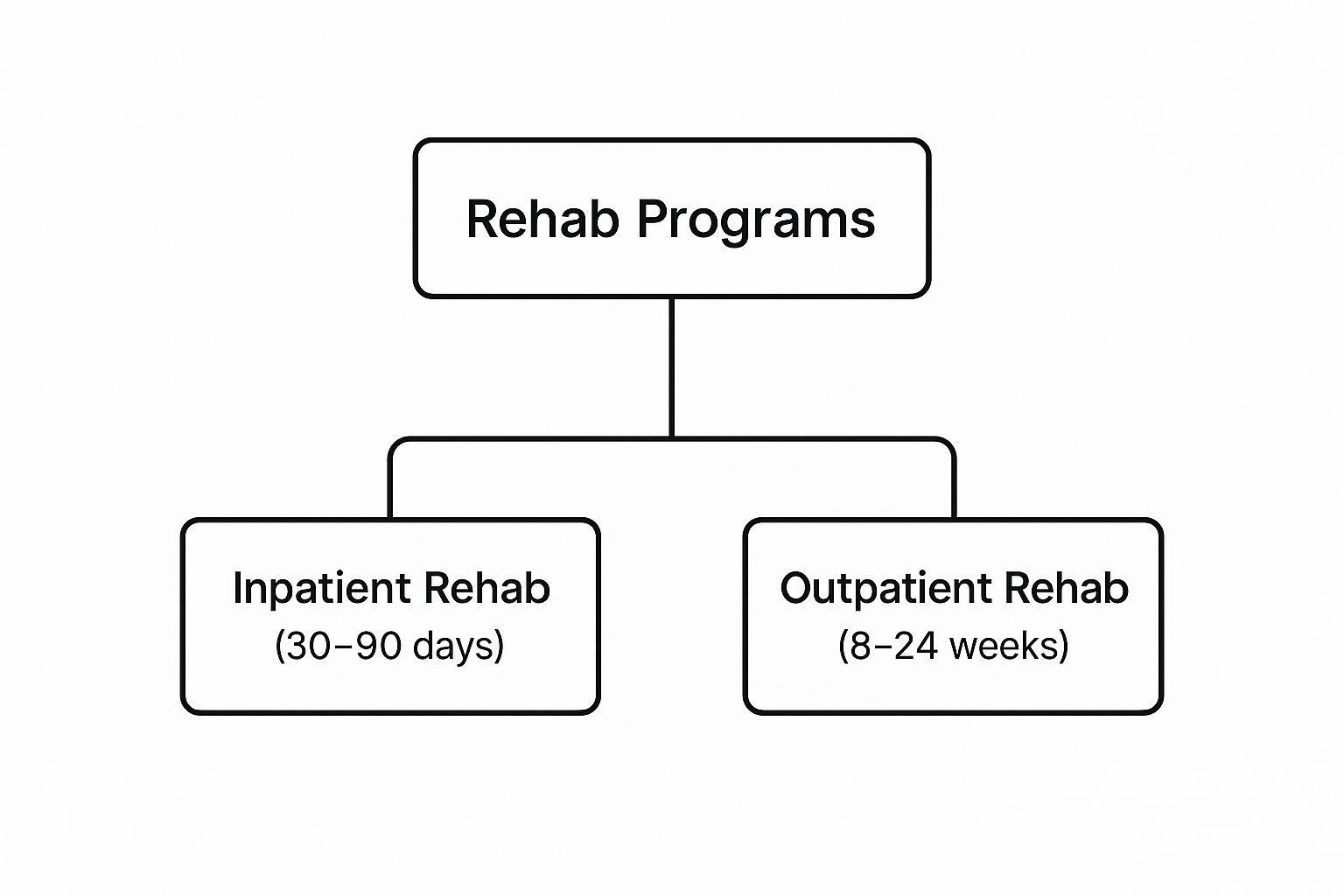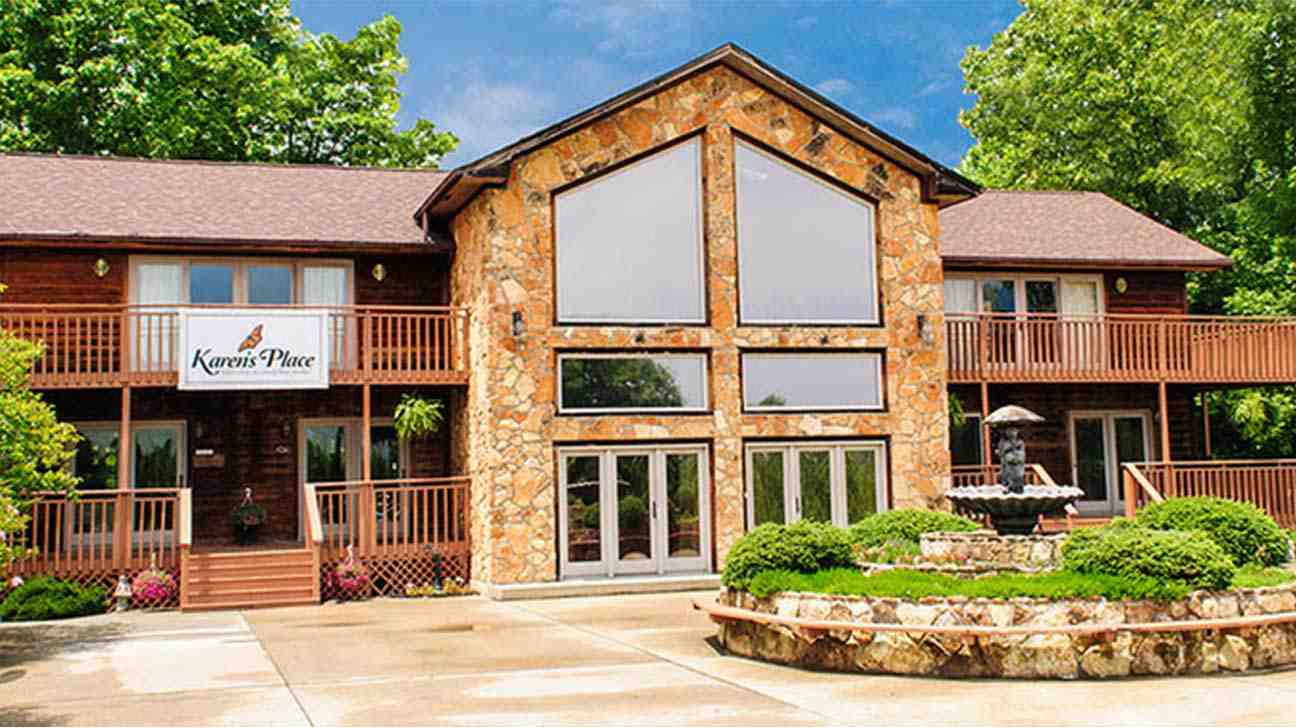
When people ask, “how long is rehab?” the most common answers you’ll hear are 30, 60, or 90-day programs. It’s helpful to think of these not as strict rules, but as well-established frameworks. Each timeline is built to support people at different stages of their journey to recovery.
What to Expect from Common Rehab Program Lengths
The length of your stay in rehab is one of the biggest factors shaping the entire experience. It’s a bit like education—a weekend workshop can give you a great introduction, but a full-semester course is where you really build deep, lasting skills. In the same way, rehab programs are structured to achieve specific goals, with the 30, 60, and 90-day models being the most common.
This infographic gives a quick overview of how long you might expect to be in either an inpatient or outpatient program.

As you can see, inpatient care tends to be a shorter, more intense dive into recovery, while outpatient programs offer longer-term support that fits into your daily life over several months.
To give you a clearer picture, here’s a quick breakdown of what each common program length usually involves.
A Quick Look at Common Rehab Timelines
| Program Length | Primary Focus | Best Suited For |
|---|---|---|
| 30-Day Program | Stabilization, detox, and foundational education on addiction and relapse prevention. | Individuals with less severe substance use history or those with strong home support systems. |
| 60-Day Program | Deeper therapeutic work, addressing underlying issues like trauma, and practicing new coping skills. | People who need more time to process and solidify the lessons from the first 30 days. |
| 90-Day Program | Building a resilient foundation for long-term sobriety, habit formation, and aftercare planning. | Individuals with severe or long-term addiction, or those who have relapsed after shorter programs. |
Each of these timelines serves a purpose, and understanding them can help you see where you might fit in.
The 30-Day Program Immersion
Think of a 30-day program as a focused boot camp for getting sober. The main goal here is to help you safely detox and stabilize, while providing an intensive crash course on the tools you need to break the cycle of addiction.
This timeline is often a great starting point for people who:
- Have a shorter history of substance use.
- Are returning to a stable and supportive home environment.
- Feel highly motivated and ready to jump right into the hard work of recovery.
In those 30 days, you’ll likely go through medically supervised detox, attend daily therapy (both one-on-one and in groups), and start learning the absolute fundamentals of preventing relapse. It’s designed to be an immersive experience that gives you a solid footing to build on.
The 60-Day Program Extension
A 60-day program includes everything from the 30-day model but gives you something incredibly valuable: more time. That extra month allows you to move past the initial shock and start practicing and truly absorbing new, healthier ways of coping.
This is where you can really begin digging into the why behind the addiction, whether it’s unresolved trauma or a co-occurring mental health condition like anxiety or depression.
“The additional time is crucial for moving beyond initial stabilization and beginning the real work of behavioral change. It allows individuals to identify triggers in a safe environment and develop healthier responses before returning home.”
The 90-Day Program Foundation
For anyone dealing with a long-term or particularly severe substance use disorder, a 90-day program is often seen as the gold standard for a reason. This extended stay provides the time and space needed to truly solidify new habits, work through complex personal issues, and build a truly resilient foundation for a life of sobriety.
Treatment needs can vary dramatically, but research and experience consistently show that more time in a structured environment leads to better long-term outcomes. The growing demand for these intensive services is undeniable, with the global addiction rehabilitation market projected to hit $31.3 billion by 2032. You can explore more rehabilitation facility statistics to grasp the scale of this need.
Ultimately, a 90-day program offers the best opportunity to not just stop using, but to truly transform your life and establish a recovery that lasts.
Call Now – Your Journey to Recovery Begins Today!

Take the first step towards a healthier life! Call now to connect with our compassionate team and start your recovery journey today. Your path to healing awaits!
Our recovery specialists are available 24/7 to provide support, and all calls are confidential and free. Reach out anytime – we’re here to help!
The Personal Factors That Shape Your Recovery Timeline

While the standard 30, 60, and 90-day programs give us a good starting point, the real answer to “how long is rehab?” is always personal. There’s no universal calendar for recovery because no two people walk the same path. The best treatment plans aren’t cookie-cutter; they’re carefully molded around your specific history, challenges, and life circumstances.
Think of it like getting a prescription from your doctor. They wouldn’t just hand the same pill at the same dose to every patient who walks in the door. Instead, they take the time to understand your unique condition and health history before recommending a treatment. Addiction recovery works exactly the same way, with a few key factors determining the ideal length of your stay.
History and Severity of Substance Use
One of the biggest pieces of the puzzle is the nature of the addiction itself. It stands to reason that someone who has been battling a severe, long-term addiction will need a longer, more intensive period of care than someone whose struggle is more recent or less severe.
A long history of substance use can create deep-seated changes in brain chemistry and behavior. Healing those connections and rewiring those patterns simply takes time. It’s the difference between pulling a small weed from a garden and uprooting a massive tree with deep roots—the tree requires far more time, effort, and care to make sure it doesn’t just grow back.
Some of the key questions we look at are:
- Duration of Use: Have you been using for a few months or many years?
- Substances Used: Is there more than one substance involved? Polysubstance use often complicates both detox and the overall treatment process.
- Previous Attempts: Have you tried to quit or been to rehab before? This isn’t a sign of failure; it’s valuable information that helps us build a stronger, more effective plan this time around.
The Role of Co-Occurring Disorders
It is incredibly common for addiction to walk hand-in-hand with mental health conditions like depression, anxiety, trauma, or bipolar disorder. When this is the case, it’s called a dual diagnosis or a co-occurring disorder, and it’s a critical factor in figuring out how long rehab should be.
“Trying to treat an addiction without addressing the underlying mental health condition is like bailing water out of a boat without plugging the hole. For recovery to last, you have to treat both at the same time.”
This kind of integrated treatment just plain requires more time. Therapists need to help you build coping skills for both the addiction and the mental health symptoms, because one can easily trigger the other. A 30-day program might barely scratch the surface of unpacking years of trauma or learning to manage a chronic anxiety disorder. A longer stay, often 60 or 90 days, gives you the runway needed to tackle these intertwined issues properly.
Your Personal Support System and Environment
Finally, what’s happening in your life outside the walls of the treatment center plays a huge role. The strength of your support network and the stability of your home environment are crucial variables. Someone who is set to return to a supportive family, a steady job, and a safe home may be ready to transition out of intensive care sooner.
On the other hand, a person facing major life stressors—like unstable housing, a toxic relationship, or a complete lack of sober friends—benefits immensely from a longer program. That extra time is an opportunity to build a much stronger foundation and a rock-solid aftercare plan before having to face those triggers head-on. At the end of the day, the right rehab duration is whatever gives you the best possible shot at healing completely and building a life you love, free from addiction.
How Different Types of Rehab Programs Affect Your Stay
When you start looking into rehab, you’ll quickly see there isn’t just one type of program. Think of it like choosing a school—some people thrive in a fully immersive, on-campus environment, while others do better with part-time classes that fit around their job and family. The kind of program you choose is probably the biggest single factor that shapes how long your treatment will last.
Broadly speaking, you have two main roads to choose from: inpatient (also called residential) and outpatient treatment. Inpatient care means you live at the facility, fully dedicating yourself to recovery with around-the-clock support. Outpatient care, on the other hand, lets you live at home and keep up with your daily life while attending treatment sessions.
Figuring out how these different approaches work is the first step in finding a path that gives you the right support for the right amount of time.
The Intensity of Inpatient Residential Rehab
Inpatient rehab is the most structured, intensive option available. By living right at the treatment center, you’re physically removed from the people, places, and daily pressures that might trigger substance use. This creates a protective bubble where you can focus entirely on getting well in a safe, medically supervised setting.
These programs most often run for 30, 60, or 90 days. The best duration for you will depend on things like your history with addiction, whether you’re also dealing with mental health issues like depression or anxiety, and how you progress once you begin. Having 24/7 access to medical professionals and therapists provides a critical safety net, especially during those first raw, vulnerable weeks of recovery.
“Living on-site removes the guesswork and a great deal of temptation. It simplifies your world down to one goal: recovery. This focused environment helps build a strong foundation before you have to navigate the complexities of daily life again.”
The Flexibility of Outpatient Rehab Programs
Outpatient programs are designed to deliver effective treatment without requiring you to put your entire life on hold. You can keep your job, stay connected with family, and sleep in your own bed. This setup works well for people who have a solid support system at home or for those who are “stepping down” from a higher level of care, like an inpatient program.
Not all outpatient care is the same. It comes in different intensities:
- Partial Hospitalization Programs (PHP): This is the most demanding type of outpatient care. You can expect to be in treatment for several hours each day, usually five days a week, making it almost like a full-time job.
- Intensive Outpatient Programs (IOP): A step down from PHP, an IOP typically involves therapy for a few hours a day, a few times a week. A standard IOP might last anywhere from 8 to 12 weeks, or sometimes longer.
- Standard Outpatient Care: This is the least intensive option, usually consisting of one or two therapy sessions per week. It’s often used as part of a long-term aftercare plan to maintain sobriety.
To help you see how these programs stack up, here’s a look at their key differences.
Comparing Rehab Formats and Typical Time Commitments
This table breaks down the intensity, time commitment, and the type of person best suited for each major rehab format. It can help you start thinking about where you might fit.
| Program Type | Level of Care | Typical Duration | Ideal Candidate |
|---|---|---|---|
| Inpatient/Residential | High-Intensity: 24/7 medical and therapeutic support while living on-site. | 30, 60, or 90 days | Someone needing to escape a triggering environment; has severe addiction or co-occurring disorders. |
| Partial Hospitalization (PHP) | High-Intensity Outpatient: 5-6 hours/day, 5 days/week. | 4-6 weeks | Needs intensive structure but has a stable, supportive home life. A good step-down from inpatient. |
| Intensive Outpatient (IOP) | Medium-Intensity Outpatient: 3-4 hours/day, 3-4 days/week. | 8-12 weeks or more | Has a moderate addiction and strong motivation. Balances treatment with work or school. |
| Standard Outpatient | Low-Intensity Outpatient: 1-2 hours/week. | Ongoing, as needed | Perfect for long-term aftercare or for individuals with a very mild substance use issue. |
Ultimately, there’s no single “best” choice—only the best choice for your unique situation. For some, the total immersion of inpatient care is what it takes to build a lasting recovery. For others, the real-world balance of an outpatient program is the key to success.
Call Now – Your Journey to Recovery Begins Today!

Take the first step towards a healthier life! Call now to connect with our compassionate team and start your recovery journey today. Your path to healing awaits!
Our recovery specialists are available 24/7 to provide support, and all calls are confidential and free. Reach out anytime – we’re here to help!
Why Recovery Is a Journey, Not a Destination

Finishing a rehab program is a huge accomplishment, and it deserves to be celebrated. But it’s a mistake to think of it as the finish line. In reality, the time you spend in a 30, 60, or 90-day program is just the first, highly structured leg of a much longer journey.
Think of it like this: your time in rehab is like learning to ride a bike with heavy-duty training wheels. You’re in a completely controlled environment, kept safe from big falls while a professional guides your every move. Aftercare is what happens when those training wheels come off. You have to learn to balance on your own, knowing you have a trusted guide nearby to help you handle the inevitable bumps in the road.
This ongoing support, often called continuing care, is what separates a temporary break from substance use and a lifetime of genuine sobriety.
Building Your Personal Support Network
Stepping out of the protective bubble of a treatment facility means walking back into a world filled with the exact triggers and pressures that likely fueled your addiction in the first place. Without a solid plan, it’s all too easy to slip back into old, destructive habits. This is precisely where aftercare becomes your lifeline.
A good aftercare plan isn’t a generic template; it’s a personal strategy built just for you. It’s designed to reinforce everything you worked so hard to learn in treatment and helps you build a new life where sobriety isn’t just possible, but natural.
Your plan will likely weave together a few key elements:
- Ongoing Therapy: Continuing with individual or group counseling gives you a dedicated space to work through challenges as they pop up in real-time.
- Support Groups: Meetings like Alcoholics Anonymous (AA) or Narcotics Anonymous (NA) offer priceless peer connection and a sense of shared accountability.
- Sober Living Homes: For many, living in a structured, substance-free home with others on the same path is a critical stepping stone back to full independence.
- Alumni Programs: Staying connected to your treatment center and the people you went through the program with creates a powerful, built-in community that truly gets it.
“Aftercare isn’t just about relapse prevention. It’s about building a rich, fulfilling life that you don’t feel the need to escape from. It gives you the structure, community, and support to turn the skills you learned in rehab into lifelong habits.”
Why Aftercare Isn’t Optional
Recovery is something you do, not something you have. It’s an active process. Much like a person with a chronic condition like diabetes has to manage their health every single day, someone in recovery needs to actively nurture their sobriety.
The tools you pick up in a 30, 60, or 90-day program are absolutely essential for this work. But aftercare is where you get to practice using those tools in the real world, with a safety net in place for the tough days and a community to cheer you on during the good ones.
If you or someone you care about is struggling, remember that confidential help is available 24/7. Making a call to a resource like Addiction Helpline America can be the first step in building that crucial support network. Ultimately, a strong aftercare plan is what transforms a temporary stay in rehab into lasting, positive change.
Lessons from Physical Rehabilitation Timelines
To really get a handle on why rehab timelines aren’t one-size-fits-all, it helps to look at a field we’re all a bit more familiar with: physical therapy.
Imagine someone breaks their leg or tears a major ligament. Their doctor doesn’t just hand them a calendar with a pre-set recovery date. Instead, their entire rehabilitation plan is built around the specific injury, how their body is healing, and what they need to get back to doing in their daily life.
That exact same logic is at the heart of effective addiction treatment. A simple sprain needs far less attention than a complex fracture, just as a more severe substance use disorder requires a longer, more in-depth approach to truly heal the underlying issues. This isn’t a new idea for addiction—it’s just good, fundamental medical practice.
Matching Time to the Severity of the Condition
Let’s look at another example of intensive recovery. For patients who’ve suffered a traumatic spinal cord injury (SCI), the average stay in an inpatient rehab facility is around 55 to 57 days. But that’s just an average. The research is clear: patients with more severe injuries need significantly longer stays to regain as much function and independence as possible. You can read more about how rehabilitation length of stay is determined in these complex cases.
This points to a basic medical truth that holds just as firm for addiction recovery.
“The duration of care must match the complexity and severity of the condition. A predetermined, one-size-fits-all timeline would fail a physical therapy patient, and it will fail someone working to overcome addiction.”
So, when you ask, “how long is rehab?” the most honest and helpful answer is always, “as long as it takes.” It’s about taking the necessary time to build a strong foundation for lasting health, whether you’re healing the body or the mind.
Call Now – Your Journey to Recovery Begins Today!

Take the first step towards a healthier life! Call now to connect with our compassionate team and start your recovery journey today. Your path to healing awaits!
Our recovery specialists are available 24/7 to provide support, and all calls are confidential and free. Reach out anytime – we’re here to help!
Your Questions About Rehab Duration, Answered
When you’re thinking about rehab, a lot of practical questions pop up. It’s completely normal to wonder about the timeline and what it means for your life. Getting clear answers helps you move forward with confidence, so let’s tackle some of the most common concerns people have.
Does Insurance Affect How Long I Can Stay in Rehab?
Yes, your insurance plan is definitely a big piece of the puzzle. Most policies have specific terms about how many days or what kind of care they’ll cover for substance use treatment. But don’t let that be the end of the story.
A good treatment center will have a dedicated team that goes to bat for you. They’ll work with your insurance company, providing the necessary clinical proof to justify the length of stay your care team recommends. The key is to have the admissions staff verify your benefits before you start, so you know exactly where you stand financially.
Is a Longer Rehab Program Always the Better Choice?
Not always. While it’s true that many studies link longer treatment with better long-term success, the “best” program is the one that fits your specific situation. The quality of the care is just as important—if not more so—than the number of days on the calendar.
Think of it this way: a focused, intensive 30-day program with a rock-solid aftercare plan can set you up for success far better than a vague, unstructured 90-day program. The goal isn’t just to pick the longest option; it’s to find the right amount of time to address your unique challenges and build a strong foundation.
“The most important thing is to see your recommended treatment plan through to the end. That completion gives you the best shot at building a recovery that truly lasts.”
What Happens If I Want to Leave Rehab Early?
Most rehab programs are voluntary, meaning they can’t physically force you to stay. However, leaving against medical advice (AMA) is something we strongly advise against. It’s very common to start feeling much better partway through treatment, but feeling better isn’t the same as being fully healed.
When you leave early, you miss out on the critical final stages of care. This is often where you learn vital relapse prevention skills and develop a concrete plan for navigating life after treatment. Sticking it out for the full duration gives you the tools and confidence you need to maintain a successful, long-term recovery.
Finding the right support often begins with a simple, honest conversation. The team at Addiction Helpline America is available 24/7 to offer confidential help and walk you through your options. You can take that first step by visiting them at https://addictionhelplineamerica.com.
Our helpline is 100%
free & confidential
If you or someone you care about is struggling with drug or alcohol addiction, we can help you explore your recovery options. Don’t face this challenge alone—seek support from us.
Programs
Resources
Will my insurance
cover addiction
treatment?
We're ready to help
Find the best
drug or alcohol treatment
center
Are you or a loved one struggling with addiction? Call today to speak to a treatment expert.















